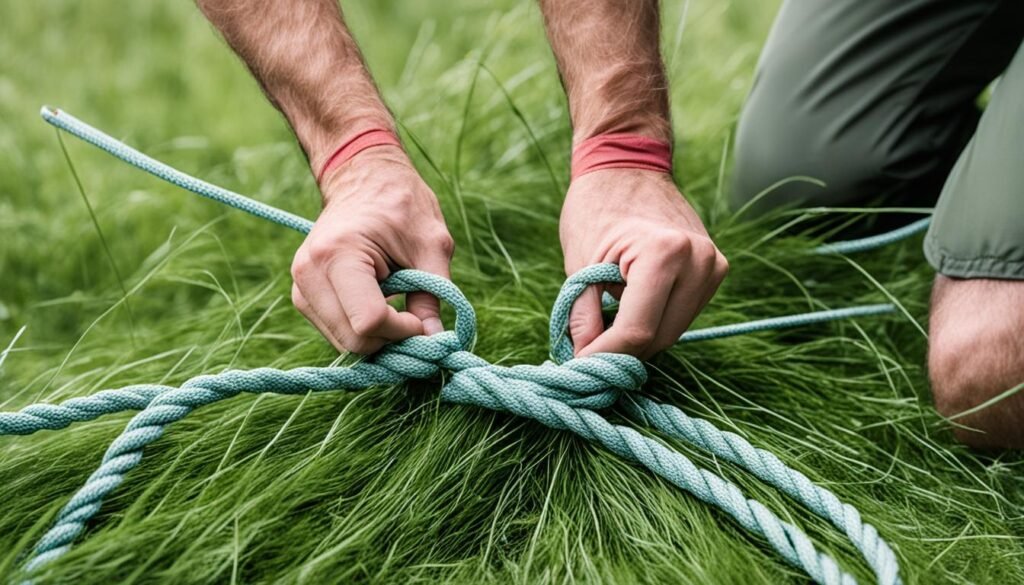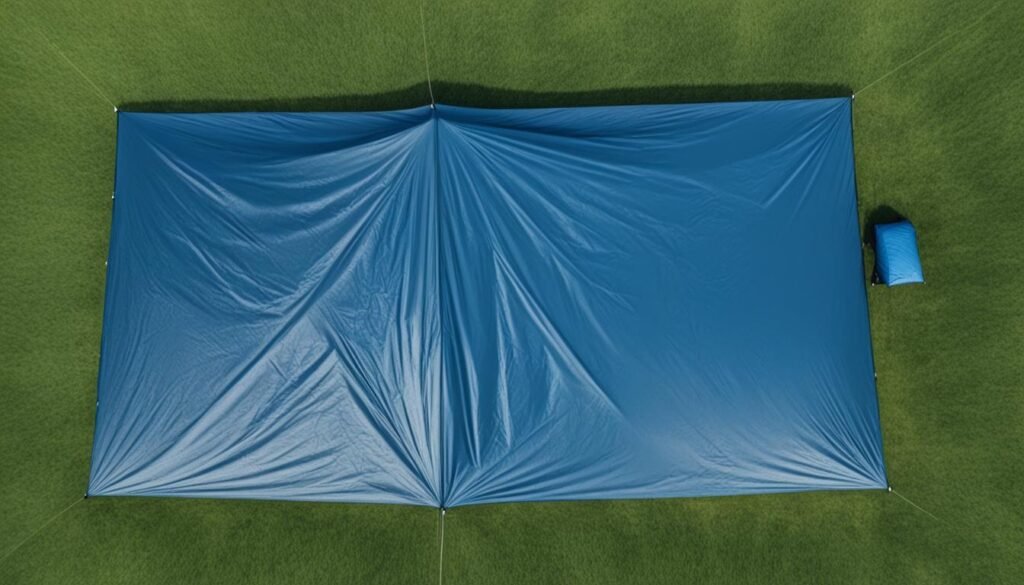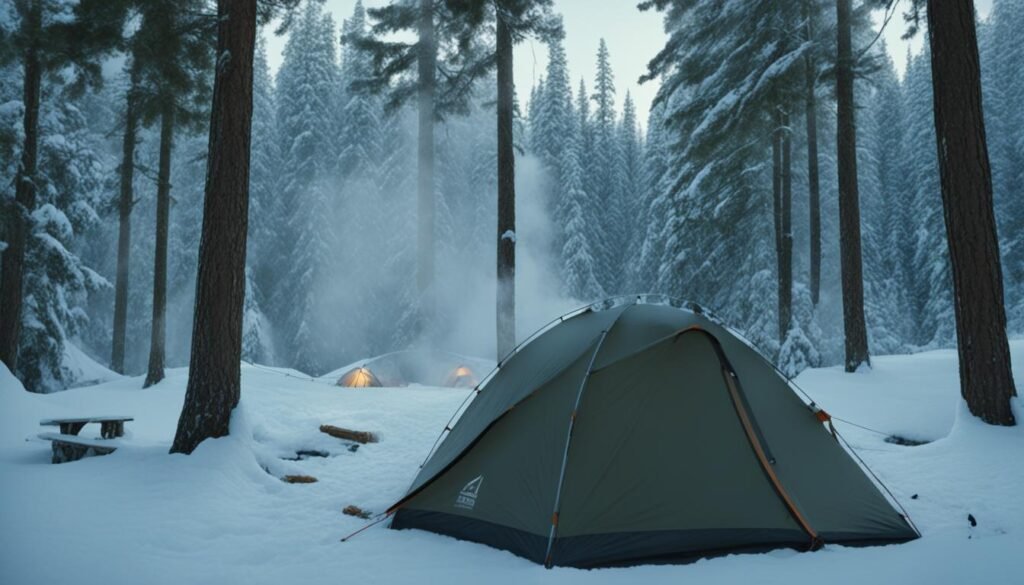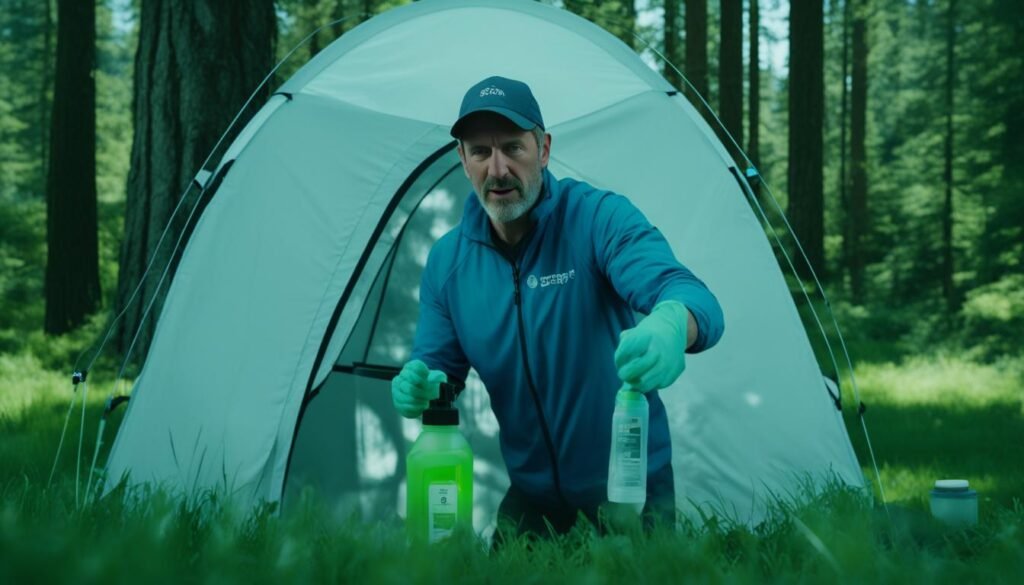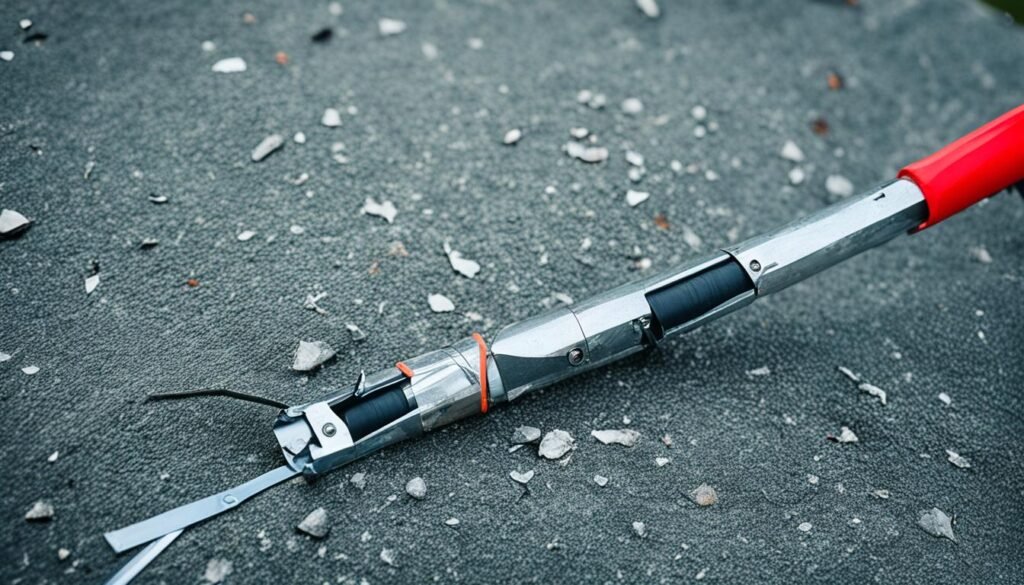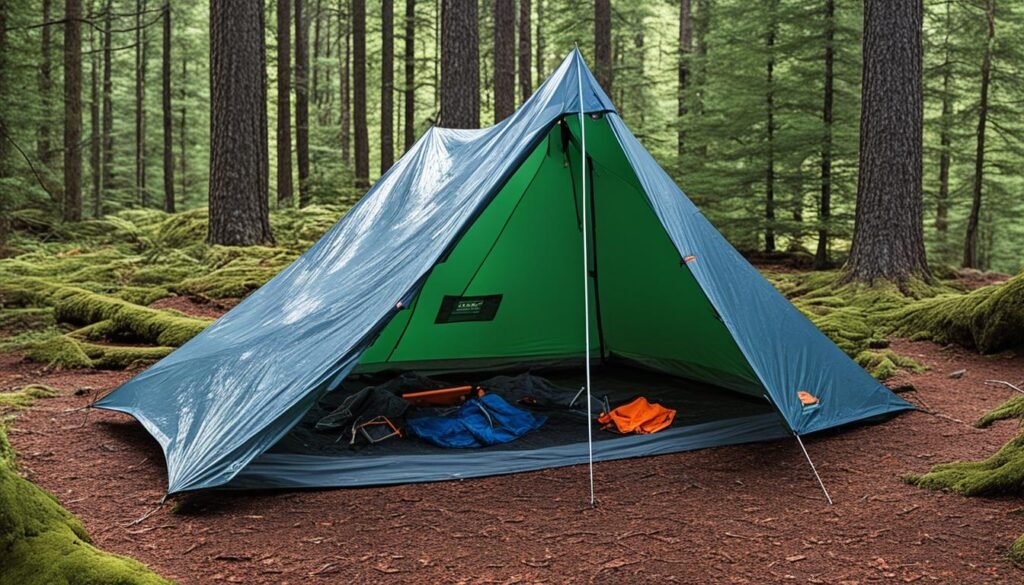Whether you’re a seasoned camper or just starting your outdoor adventures, mastering essential knots is a fundamental skill. These knots serve both safety and utility purposes, ensuring you can navigate various camping scenarios with confidence. In this guide, we’ll delve into the art of knot tying, exploring different types of knots and their practical applications in camping, so you can be well versed in the world of knots!
Key Takeaways:
- Learn how to tie a knot for tent stakes to ensure stability and security.
- Discover the best knots for tent stakes, providing effective and secure grip.
- Explore knot tying techniques specifically designed for camping.
- Get valuable tips on tying strong knots for securing tent stakes.
- Find step-by-step tutorials for tying tent stake knots.
Chapter 1: Basic Knots for Camping
Every camper’s journey begins with mastering the basics. These fundamental knots lay the foundation for more complex techniques. Let’s explore the essential camping knots that every outdoor enthusiast should know.
The Figure-Eight Knot
The figure-eight knot is a basic knot that serves as a starting point for many other knots. It creates a secure loop at the end of a rope, making it ideal for securing equipment or creating makeshift handles in camping situations. The figure-eight knot is easy to tie and untie, making it a versatile option for various situations.
The Two Half-Hitches Knot
The two half-hitches knot is another essential knot for camping. It is perfect for securing a rope to a tree or pole, allowing you to create clotheslines, hammocks, or shelters. With its simple yet effective design, the two half-hitches knot provides stability and reliability, ensuring your campsite is safe and secure.
| Knot | Function |
|---|---|
| Figure-Eight Knot | Creating secure loops |
| Two Half-Hitches Knot | Securing ropes to trees or poles |
“Learning these basic knots is crucial for any camping adventure. They provide the building blocks for more intricate knots and give you the confidence to handle various outdoor situations with ease.” – Experienced Camper
Mastering these essential camping knots will enhance your camping experience and give you the skills needed to tackle a wide range of outdoor challenges. Practice these knots regularly to ensure you can tie them confidently in any situation.
Square Knot
The square knot is a versatile knot that is ideal for joining two ropes of equal diameter. It’s a go-to for securing loads, creating makeshift clotheslines, or bundling camping gear.
When it comes to joining ropes, the square knot is a reliable choice. Its symmetrical structure ensures a tight and secure connection, providing peace of mind in various camping situations. Whether you need to secure a load to your backpack or bind two ropes together, the square knot has got you covered.
One of the practical applications of the square knot is creating makeshift clotheslines. Simply tie a square knot at each end of a rope, find two sturdy anchor points, and hang your wet clothes to dry. This knot ensures stability, allowing you to make the most of limited space in your campsite.
Another useful application of the square knot is bundling camping gear. When you need to organize and transport your equipment, the square knot keeps everything in place. Whether it’s your sleeping bag, tent poles, or hiking gear, tying a square knot securely bundles and prevents items from shifting during transportation.
The square knot: a reliable and versatile knot for joining ropes, securing loads, creating makeshift clotheslines, and bundling camping gear.
Step-by-Step Guide: Tying a Square Knot
- Take two ropes of equal diameter and cross them over each other.
- Take the end of the left rope and pass it over the right rope, creating a loop.
- Take the end of the right rope and pass it over the left rope.
- Insert the end of the right rope through the loop created by the left rope.
- Pull both rope ends in opposite directions to tighten the knot.
- Ensure the knot is secure by checking that the ropes lie parallel to each other.
With practice, tying a square knot becomes second nature. Remember to maintain tension while tying to ensure a tight and secure knot.
| Pros | Cons |
|---|---|
| Easy to tie and untie | Not suitable for joining ropes of different diameters |
| Versatile and reliable | May come loose if not properly tightened |
| Creates a symmetrical and balanced knot |
Bowline Knot
The Bowline knot is a knot renowned for its strength, reliability, and versatility. It creates a non-slip loop at the end of a rope, making it an essential knot for securing tents and tarps or any scenario where a strong fixed loop is needed.
What sets the Bowline knot apart is its ability to maintain its strength even under intense tension. The loop created by the Bowline knot remains firm and secure, providing peace of mind when securing your camping gear.
When it comes to securing tents, the Bowline knot ensures that your shelter stays in place even in challenging weather conditions. Its steadfast grip eliminates the worry of your tent coming loose, allowing you to sleep soundly throughout the night.
For tarps, the Bowline knot offers a reliable anchoring solution. Whether you’re using a tarp to provide shade or protect your equipment, the strength of the Bowline knot ensures that your tarp remains securely in place, even in strong winds.
With its ability to create a strong fixed loop, the Bowline knot is a valuable addition to any camper’s knot repertoire. Its reliability and ease of tying make it an essential knot for various outdoor applications.
Key Features of the Bowline Knot:
- Strength and reliability: The Bowline knot maintains its strength even under intense tension, making it ideal for securing tents and tarps.
- Non-slip loop: The loop created by the Bowline knot stays secure, providing peace of mind in various camping scenarios.
- Versatility: The Bowline knot is suitable for securing tents, tarps, and other camping gear that requires a strong fixed loop.
Mastering the Bowline knot will enhance your camping experience by providing you with a secure and dependable knot for a wide range of applications. Keep practicing and perfecting this essential knot, and you’ll be well-prepared for your next outdoor adventure.
Clove Hitch
The clove hitch is a quick and simple knot that proves invaluable in attaching a rope to a post or tree, facilitating efficient campsite setup. Its versatility and ease of tying make it a popular choice among campers and outdoor enthusiasts.
Whether you need to secure a clothesline, create a temporary anchor point, or fasten your tarp, the clove hitch provides a reliable solution. With just a few simple steps, you can establish a sturdy connection between your rope and the desired object.
To tie a clove hitch, follow these steps:
- Pass the rope over the post or tree.
- Cross the rope over itself.
- Bring the rope under the post or tree.
- Pass the rope over itself again.
- Tighten the knot by pulling both ends of the rope.
Once tied, the clove hitch firmly grips the object, providing a secure attachment point for a variety of camping needs. Its simplicity and strength make it an essential knot in your repertoire.
Benefits of the Clove Hitch:
Before we conclude, let’s explore some of the key advantages of using the clove hitch:
- Efficiency: The clove hitch can be tied quickly and easily, allowing you to expedite your campsite setup.
- Versatility: This knot adapts well to various camping scenarios, making it suitable for attaching ropes to different objects.
- Secure Attachment: Once tied, the clove hitch provides a reliable and secure connection, ensuring your equipment and gear stay in place.
- Adjustability: Should you need to move or adjust your setup, the clove hitch can be easily untied and retied without compromising its strength.
Chapter 2: Knots for Securing Tents and Tarps
Ensuring the stability of your shelter is essential when camping, especially in various weather conditions. The right knots can provide the strength and security you need to keep your tents and tarps firmly in place. Let’s explore some knots specifically designed for securing tents and tarps, including adjustable loops and sliding knots.
Knots for Securing Tents
When it comes to securing tents, you want knots that will withstand strong winds and keep your shelter stable. Here are a few knot options:
Square Knot: The square knot is a versatile knot used for joining two ropes of equal diameter. It can be used to secure tent lines, ensuring your tent remains stable even in windy conditions.
Bowline Knot: The bowline knot creates a strong, non-slip loop at the end of a rope. It’s perfect for securing tent lines and creating a fixed loop that can withstand tension and unpredictable weather.
Knots for Securing Tarps
Tarps provide essential coverage and protection in outdoor settings. Properly securing them allows for a reliable shelter and peace of mind. Here are a few knots to consider for securing tarps:
Taut-Line Hitch: The taut-line hitch is an adjustable loop knot that excels at securing tarps. With its ability to be easily tightened or loosened, it provides stability in various weather conditions, ensuring your tarps stay secure.
Klemheist Knot: The klemheist knot is excellent for securing tarps as it grips the rope under tension, providing a sliding knot that can be easily adjusted. It offers a reliable way to secure tarps for shelter or create a shaded area in your camp.
Mastering these knots will give you the confidence to secure your tents and tarps effectively, providing stability in various weather conditions. Practice and familiarize yourself with these knot-tying techniques to ensure a safe and secure camping experience.
| Knot | Application | Advantages |
|---|---|---|
| Square Knot | Securing tent lines | Versatile for joining ropes |
| Bowline Knot | Securing tent lines | Creates a strong, non-slip loop |
| Taut-Line Hitch | Securing tarps | Adjustable loop for stability |
| Klemheist Knot | Securing tarps | Sliding knot for easy adjustment |
Taut-Line Hitch
When it comes to securing tent guylines and adapting to changing weather conditions, the taut-line hitch is a knot that you’ll want to add to your repertoire. This adjustable loop knot provides the flexibility you need to keep your tent stable in any conditions.
The taut-line hitch is designed to allow for easy tightening or loosening of your tent guylines. Its adjustable loop feature enables you to adapt to changing weather conditions, ensuring your tent remains secure even in gusty winds or shifting terrain.
This knot is particularly useful when camping in areas with unpredictable weather patterns. If you anticipate changes in wind direction or intensity, the taut-line hitch allows you to easily adjust the tension of your tent guylines, keeping your shelter stable and secure.
By using the taut-line hitch, you can have peace of mind knowing that your tent is anchored and adaptable. It’s a valuable knot to have in your camping toolkit, providing the versatility needed to navigate various weather conditions.
So, the next time you embark on a camping adventure, make sure to master the taut-line hitch. Its adjustable loop and secure design will help you secure your tent guylines and adapt to changing weather conditions, ensuring a comfortable and stable camping experience.
Keep in mind that different knots serve different purposes, so it’s important to learn and practice a variety of knot tying techniques to enhance your camping skills. In the next section, we’ll explore the klemheist knot, another valuable knot for securing tarps and creating versatile camp setups.
Klemheist Knot
The klemheist knot is a valuable addition to your knot-tying repertoire when it comes to securing tarps. This sliding knot offers a reliable way to secure tarps for shelter or create a shaded area in your camp. The klemheist knot is especially useful when you need to adjust the tension of the tarp or quickly release it.
The klemheist knot is formed by wrapping the working end of the rope around the standing part, creating a sliding loop that can be easily moved along the rope. As tension is applied, the klemheist knot grips the rope, ensuring a secure hold. This knot is simple to tie and untie, making it an efficient choice for securing tarps in outdoor environments.
To tie a klemheist knot, follow these steps:
- Start by forming a small loop in the rope.
- Bring the working end of the rope around the standing part, crossing over the loop.
- Loop the working end behind the standing part and bring it through the loop.
- Tighten the knot by pulling the working end while holding onto the standing part.
- To release the knot, simply pull the working end, and the knot will slide open.
The klemheist knot is an excellent choice for securing tarps due to its ability to adjust the tension easily. Whether you’re setting up a tarp as a shelter, creating a shaded area, or need to secure it in strong winds, the klemheist knot provides a reliable method for keeping your tarps in place.
Benefits of the Klemheist Knot for Securing Tarps
The klemheist knot offers several advantages when it comes to securing tarps:
- Reliable Grip: The sliding nature of the klemheist knot allows it to grip the rope tightly under tension, providing a secure hold on the tarp.
- Easy Adjustment: The klemheist knot can be easily adjusted to tighten or loosen the tension of the tarp, allowing for quick adaptations to changing weather conditions.
- Quick Release: When it’s time to pack up or remove the tarp, the klemheist knot can be released by pulling the working end, allowing for a swift and hassle-free removal.
- Versatility: The klemheist knot can be used with a variety of ropes or cords, making it adaptable to different tarp sizes and types of camping gear.
Mastering the klemheist knot will enhance your ability to secure tarps effectively, ensuring that your shelter remains stable and protected in various outdoor conditions.
| Knot | Pros | Cons |
|---|---|---|
| Klemheist Knot | Reliable grip, easy adjustment, quick release, versatility | May require practice to tie correctly |
| Square Knot | Simple to tie, secure for lightweight tarps | Not suitable for heavy loads or high tension |
| Bowline Knot | Strong, non-slip loop, versatile for various tarp setups | Can be difficult to untie after heavy tension |
Chapter 3: Knots for Climbing and Rappelling
For those adventurers who explore beyond the campsite, knowing knots for climbing and rappelling is crucial. These knots ensure your safety in vertical environments when paired with a carabiner.
Knots for Climbing
When it comes to climbing, having reliable knots is essential for your safety and success. Here are some key knots to master:
- Figure-Eight Follow-Through: The figure-eight follow-through is a fundamental knot in climbing systems. It’s secure and easy to inspect, making it a reliable choice for tying into a climbing harness.
- Prusik Knot: The prusik knot is invaluable for rappelling. This friction knot allows you to descend or ascend a rope safely, serving as a backup for added security during descents.
These knots provide the foundation for your climbing systems, ensuring stability and safety as you navigate vertical terrain.
Knots for Rappelling
When rappelling, it’s crucial to have knots that provide friction for controlled descents. Here are two knots that are commonly used:
- Figure-Eight Follow-Through: As mentioned earlier, the figure-eight follow-through is a reliable knot for securing yourself to the rappel rope.
- Prusik Knot: The prusik knot serves as a backup knot when rappelling, providing additional security during descents.
These friction knots play a vital role in ensuring a safe descent while rappelling.
When engaging in climbing or rappelling activities, it’s essential to follow proper safety protocols and use the appropriate equipment. These knots are just one piece of the larger puzzle in maintaining safety in vertical environments.
Remember, always seek proper training and guidance from experienced climbers or professional instructors before attempting any climbing or rappelling activities on your own.
With the right knowledge and skills in knot tying, you can confidently explore the thrilling world of climbing and rappelling, backed by the security and control these knots provide.
Figure-Eight Follow-Through
When it comes to climbing systems, the figure-eight follow-through knot takes center stage. This knot is not only secure but also easy to inspect, providing climbers with peace of mind as they tie into their harnesses. Whether you’re a seasoned climber or just starting out, understanding the figure-eight follow-through is crucial for your safety on the rock.
One of the key advantages of the figure-eight follow-through is its simplicity. It consists of a figure-eight knot followed by threading the rope back through the initial loop, creating a secure and self-locking connection. This knot’s shape allows for easy identification and inspection, making it a favorite among climbers who prioritize safety.
With the figure-eight follow-through, climbers can trust that their rope is tied securely to their climbing harness, providing a reliable connection between the climber and the rope. This knot’s strong and straightforward design ensures that it won’t come undone, even under immense tension and strain.
In addition to its secure nature, the figure-eight follow-through offers easy inspection. Climbers can quickly assess the integrity of the knot by examining its symmetrical shape and confirming that the rope is correctly threaded. This simplicity makes it an ideal knot for climbers to rely on, especially in situations where they need to perform routine safety checks.
One vital aspect of climbing is ensuring that all knots are tied correctly. The figure-eight follow-through is no exception. It is essential for climbers to carefully follow the proper tying technique and double-check their knots before venturing onto the rock face. A single mistake or oversight can compromise the safety of the entire climbing system.
So, remember to take the time to practice tying the figure-eight follow-through until it becomes second nature. Your climbing harness should always be your lifeline, and a secure knot is the foundation of a safe climbing experience.
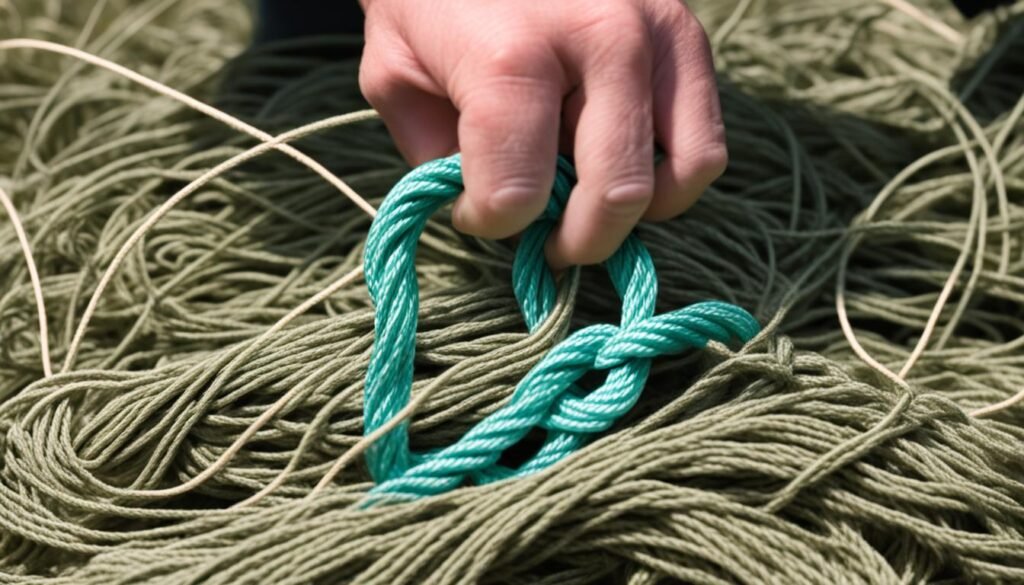
| Pros | Cons |
|---|---|
| The figure-eight follow-through is a secure knot that provides a reliable connection between the climber and the rope. | It requires precision and attention to detail when tying to ensure the knot is correctly formed. |
| The knot is easy to inspect, allowing climbers to quickly assess its integrity and identify any potential issues. | It can be time-consuming to tie and untie compared to other knots. |
| The figure-eight shape and threading make it visually distinctive and easy to recognize. | It may not be the most suitable knot for situations requiring quick adjustments or frequent retying. |
| The figure-eight follow-through is commonly used in climbing systems and has stood the test of time as a trusted knot. | It is essential to learn and practice the proper tying technique to ensure the knot’s security. |
Prusik Knot
The Prusik knot is an essential skill for rappelling, providing a valuable backup for added security during descents. This friction knot allows you to confidently descend or ascend a rope, ensuring your safety while navigating vertical terrains.
When rappelling, the Prusik knot acts as a reliable friction point on the rope, allowing you to control your descent speed. It’s especially useful when descending steep or slippery surfaces, providing an extra layer of safety and control.
The Prusik knot is formed by creating a loop with a smaller diameter nylon cord around the main rope. As you descend, the knot grips tightly, providing friction to slow your descent or stop it completely if needed. This knot is particularly useful in situations where a traditional rappel device may not be available or as a backup to your primary descent system.
By mastering the Prusik knot, you expand your repertoire of rappelling techniques, making you more versatile and adaptable in different scenarios. Whether you’re an experienced climber tackling new challenges or a beginner looking to explore rappelling, this knot is a valuable addition to your skill set.
Practice tying the Prusik knot until you can confidently execute it in various rappelling situations. Remember, safety is paramount, so always double-check your knots and use proper equipment when rappelling.
Chapter 4: Practical Uses for Everyday Knots
Beyond specific camping scenarios, knots have practical uses in various situations, enhancing your overall camping experience. Here are some practical applications for the knots you’ve mastered:
Securing Rope to a Tree or Pole
One practical use for knots is securing ropes to trees or poles. This allows you to create a stable anchor point for various purposes. Whether you need to hang a hammock, set up a clothesline, or create a boundary around your campsite, knowing how to tie a secure knot to a tree or pole is essential.
Creating a Temporary Handhold or Foothold
Another practical application of knots is creating temporary handholds or footholds. When exploring steep or challenging terrain, you may encounter areas where a secure grip or step is needed. By tying knots in strategic locations, you can create temporary handholds or footholds to provide the stability and confidence you need to navigate these obstacles safely.
“Knots are not only practical but can also be lifesaving in challenging terrain. A well-placed knot can provide the stability and support needed to navigate difficult situations with ease.”
Additionally, knots can be used in various other everyday situations, such as securing equipment, bundling items together, or improvising tools. The versatility of knots allows you to adapt and problem-solve in different scenarios, making them a valuable skill to have in your camping repertoire.
Practical Uses for Everyday Knots Table
| Knot | Practical Use |
|---|---|
| Square Knot | Joining ropes, securing loads, bundling camping gear |
| Bowline Knot | Securing tents, securing tarps, creating a strong fixed loop |
| Clove Hitch | Attaching rope to a post or tree, efficient campsite setup |
| Two Half-Hitches | Securing rope to a tree or pole, versatile choice for various campsite needs |
| Truckers Hitch | Creating a temporary handhold or foothold, securing loads, tightening lines |
By understanding the practical uses of knots and mastering their techniques, you’ll be well-prepared to handle various camping situations with confidence and ingenuity.
Two Half-Hitches
When it comes to securing a rope to a tree or pole, the two half-hitches knot is a versatile choice for various campsite needs. This knot is quick to tie and untie, making it convenient for different scenarios during your outdoor adventures.
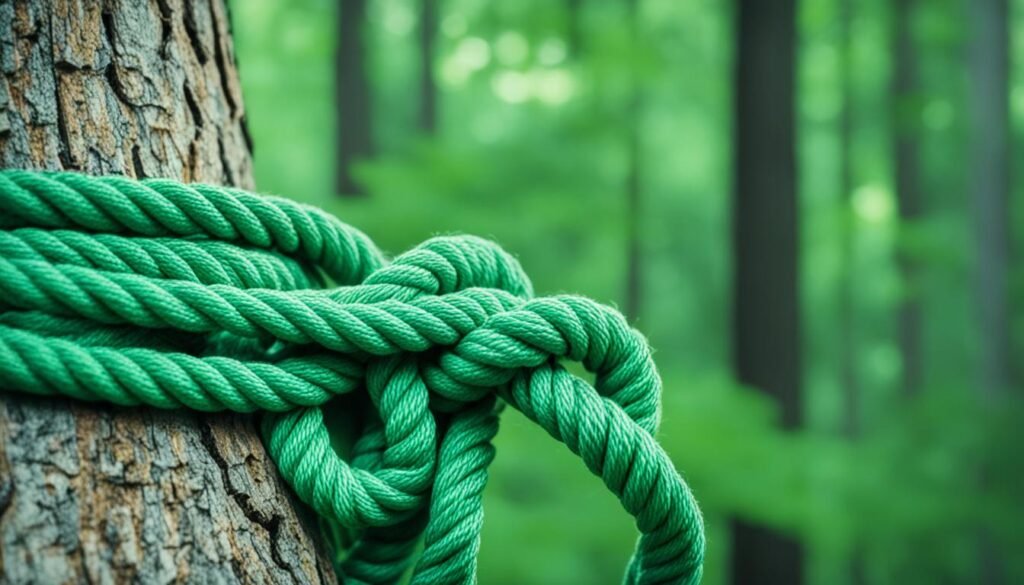
By using two half-hitches, you can create a reliable and secure attachment point. Whether you need to secure a tarp, hang a clothesline, or tie down camping equipment, this knot provides the stability and peace of mind you need in your campsite setup.
Truckers Hitch
The truckers hitch is a versatile knot that excels in creating a temporary handhold or foothold. It is a combination of knots that forms a pulley system, providing a mechanical advantage for securing loads or tightening lines. This knot is widely used by truckers and campers alike due to its effectiveness in various situations.
By utilizing the truckers hitch, you can easily secure heavy loads on trucks and trailers, ensuring they stay firmly in place during transit. This knot allows you to create a tight and secure connection, minimizing the risk of shifting or falling cargo. It provides the stability and peace of mind that every truck driver or camper desires.
Moreover, the truckers hitch is a valuable asset in tying down tents, tarps, and other gear at your campsite. With its mechanical advantage, you can effortlessly tighten the lines, ensuring your shelter and equipment remain secure, even in windy conditions. This knot gives you the confidence to enjoy your camping experience without worrying about loose or flapping tarps.
The truckers hitch is known for its simplicity and efficiency. With a few straightforward steps, you can create a strong and reliable knot that withstands the demands of securing loads and tightening lines. Whether you’re a trucker transporting goods or a camper setting up camp, mastering this knot is essential for ensuring the safety and stability of your cargo or gear.
“The truckers hitch is a game-changer when it comes to securing loads on my truck. It provides the tightness and stability I need, giving me peace of mind during long journeys.”
Next, let’s take a closer look at the step-by-step process of tying the truckers hitch:
- Create a fixed loop by forming a bight in the rope.
- Pass the working end of the rope through the loop, creating a slipped loop.
- Wrap the working end around a secure anchor point, such as a pole or tree.
- Pass the working end through the slipped loop, creating a loop with a mechanical advantage.
- Tighten the knot by pulling the working end of the rope, utilizing the mechanical advantage of the loop.
- Safely secure the working end of the rope to prevent any slippage.
By following these steps, you’ll be able to master the truckers hitch and unlock its full potential in creating temporary handholds or footholds, securing loads, and tightening lines. Practice this knot and elevate your camping or trucking experience with its reliability and efficiency.
What Are the Best Knots to Use for Driving Tent Stakes into Hard Ground?
When dealing with hard ground, having the right tips for driving pegs can make all the difference. The best knots to use for driving tent stakes into tough, compacted soil are the Figure 9, Taut-line hitch, and the Trucker’s hitch. These knots provide added tension and stability, ensuring a secure setup.
Conclusion
Mastering essential knots is more than just a practical skill – it’s a gateway to enhancing your camping experience and building confidence in various outdoor scenarios. Whether you’re setting up camp, securing your gear, or venturing into more challenging terrain, the art of knot tying is a fundamental aspect of becoming a well-rounded camper.
By mastering a variety of knots, you’ll be equipped with the knowledge and skills to handle any situation that may arise during your camping adventures. Tying the perfect knot for stability when pitching your tent, securing tarps against the elements, or creating temporary handholds or footholds are just a few examples of how these knots can greatly enhance your camping experience.
Imagine the satisfaction and peace of mind that come with knowing you have the ability to navigate a wide range of camping scenarios confidently. By dedicating time and effort to practice these knots, you’ll develop a level of proficiency that will not only impress your fellow campers but also provide you with a sense of self-reliance in the great outdoors.
So, grab your ropes, revisit the techniques you’ve learned, and continue honing your knot tying skills. With each knot you master, you’ll deepen your connection with nature and empower yourself to take on new adventures with the utmost confidence. Happy camping!
FAQ
What are some basic knots for camping?
The square knot, bowline knot, and clove hitch are essential camping knots that every outdoor enthusiast should know.
How do I tie a square knot?
To tie a square knot, start by crossing the right end over the left end. Then, bring the right end under and through the loop. Finally, cross the left end over the right end and bring it under and through the loop.
What is the bowline knot used for?
The bowline knot creates a non-slip loop at the end of a rope. It is perfect for securing tents, tarps, or any scenario where a strong, fixed loop is needed.
How do I tie a clove hitch knot?
To tie a clove hitch knot, wrap the rope around a post or tree, cross it over itself, and loop it back around the post or tree. Then, tuck the end under the last wrap to secure the knot.
What are some knots for securing tents and tarps?
The taut-line hitch is ideal for securing tent guylines, while the klemheist knot is useful for securing tarps.
How do I tie a taut-line hitch?
To tie a taut-line hitch, create a loop around the tent guylines. Then, pass the working end of the rope through the loop, wrap it around the standing part of the rope, and pass it through the loop again. Finally, tighten and adjust as needed.
What is a klemheist knot used for?
The klemheist knot is used for securing tarps. It is a sliding knot that grips the rope under tension, providing a reliable way to secure tarps for shelter or create a shaded area in your camp.
What are some knots for climbing and rappelling?
The figure-eight follow-through is commonly used in climbing systems, while the prusik knot is invaluable for rappelling.
How do I tie a figure-eight follow-through knot?
To tie a figure-eight follow-through knot, create a loop with the rope and pass the working end through the loop. Then, weave the working end around and behind the standing part of the rope, and pass it through the loop again. Finally, tighten and ensure the knot is properly formed.
What is a prusik knot used for?
The prusik knot is used for rappelling. It functions as a friction knot that allows you to safely descend or ascend a rope, serving as a backup for added security during descents.
How do I tie a two half-hitches knot?
To tie a two half-hitches knot, wrap the rope around a tree or pole, pass the end of the rope over itself, and tuck it under the standing part. Repeat this process to create two half-hitches, tightening them as needed.
What is the truckers hitch used for?
The truckers hitch is used for creating a temporary handhold or foothold. It is a combination of knots that creates a pulley system, providing a mechanical advantage for securing loads or tightening lines.
How do I tie a truckers hitch?
To tie a truckers hitch, start by tying a slipknot near the end of the rope. Then, create a loop near the slipknot and pass the working end through the loop. Finally, pull the working end to tighten the loop and secure the load, creating tension with the slipknot.
Why is mastering knot tying important for camping?
Mastering knot tying is important for camping as it ensures the stability and security of your tent, tarps, and gear. It also enhances your overall camping experience by providing confidence in various camping scenarios.

